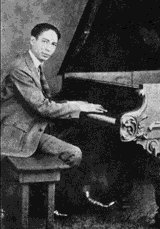

Jelly Roll Morton
The remarkable pianist, composer, and bandleader Jelly Roll Morton (1890-1941) was a key figure in the evolution of ragtime into jazz. His musical development took place in the international atmosphere of New Orleans, where he was born. The child of a broken family, by 1902 he was working as a pianist in the "sporting houses" of Storyville, generally regarded as the birthplace of jazz. In addition to the then-popular ragtime styles, Morton was conversant with opera, traditional European art music and, perhaps most significantly, blues and Caribbean dance music.
Billy Goat Stomp is a great example of Morton's unparalleled ability to invent pieces of the greatest musical interest from the simplest harmonic materials. While the tune is based a progression utilizing only two chords, modulating halfway through the piece from major to minor, one experiences it as a fresh, constantly developing set of variations.
Chicago Breakdown (1926) was originally recorded as the piano solo Stratford Hunch in a pathbreaking session for Gennett records in June 1924.
Dead Man Blues’s funereal mood is set by the opening quote from Flee as a bird to the mountain, a popular dirge of old New Orleans.
Hyena Stomp (1927) is a wonderful example of Morton's unparalleled ability to invent pieces of the greatest musical interest from the simplest harmonic materials. Comprised of one simple sixteen-bar progression in the same key throughout the whole piece, it becomes an exciting and constantly surprising set of variations with great formal momentum.
The Jelly Roll Blues is one of Morton’s earliest compositions (he claimed to have written it in 1905), and clearly it was in JMorton’s repertoire prior to the publication of Handy's Memphis Blues in 1912.
Influenced by the international atmosphere of early 20th-century New Orleans, Morton's music shows at times a distinct "Latin tinge" and an unusually far-reaching harmonic sophistication and rhythmic variety, in addition to the traditional hallmarks of New Orleans style. London Blues (also known as Shoe Shiner's Drag) is one of the earliest orchestrations of Morton's music issued by the Melrose Company in Chicago. (Our performance is based on the original string parts from the 1923 edition.) The piece is in the form of a series of blues choruses, ending with an "organ chorus" of sustained notes.
Consisting of a verse that is a 12-bar blues and a chorus based on a traditional New Orleans chord progression, Midnight Mamma demonstrates Morton's highly idiosyncratic approach to key relationships, creating a piece that is full of surprises yet logical in its own terms.
Mister Jelly Lord, in which Morton (never noted for his self-effacing personality) sang his own praises, is an uncharacteristic Tin-Pan-Alley-style verse-chorus form, yet it is pervaded by Morton’s unique harmonic and melodic language.
Sidewalk Blues (1926) opens with a distinctive off-beat accompaniment of its first theme, and closes with a song-form "organ chorus" of sustained chords, serving as a framework and background for an improvised solo.
Wild Man Blues was originally composed as Ted Lewis Blues by Morton in early 1927, and was recorded later in the year in a slightly altered version called Wild Man Blues by Louis Armstrong. The piece is in the form of a 32-bar song, rather than the 12-bar structure usually associated with the blues idiom.
Notes by Roy Wiseman